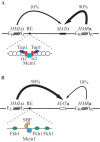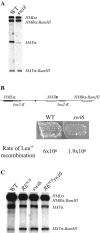Cell cycle-dependent regulation of Saccharomyces cerevisiae donor preference during mating-type switching by SBF (Swi4/Swi6) and Fkh1
- PMID: 16809780
- PMCID: PMC1592702
- DOI: 10.1128/MCB.02443-05
Cell cycle-dependent regulation of Saccharomyces cerevisiae donor preference during mating-type switching by SBF (Swi4/Swi6) and Fkh1
Abstract
Saccharomyces mating-type switching occurs through a double-strand break-initiated gene conversion event at MAT, using one of two donors located distantly on the same chromosome, HMLalpha and HMRa. MATa cells preferentially choose HMLalpha, a decision that depends on the recombination enhancer (RE) that controls recombination along the left arm of chromosome III. We previously showed that an fhk1Delta mutation reduces HMLalpha usage in MATa cells, but not to the level seen when RE is deleted. We now report that donor preference also depends on binding of the Swi4/Swi6 (SBF) transcription factors to an evolutionarily conserved SCB site within RE. As at other SCB-containing promoters, SBF binds to RE in the G(1) phase. Surprisingly, Fkh1 binds to RE only in G(2), which contrasts with its cell cycle-independent binding to its other target promoters. SBF and Fkh1 define two independent RE activation pathways, as deletion of both Fkh1 and SCB results in nearly complete loss of HML usage in MATa cells. These transcription factors create an epigenetic modification of RE in a fashion that apparently does not involve transcription. In addition, the putative helicase Chl1, previously involved in donor preference, functions in the SBF pathway.
Figures





Similar articles
-
Regulation of budding yeast mating-type switching donor preference by the FHA domain of Fkh1.PLoS Genet. 2012;8(4):e1002630. doi: 10.1371/journal.pgen.1002630. Epub 2012 Apr 5. PLoS Genet. 2012. PMID: 22496671 Free PMC article.
-
Saccharomyces forkhead protein Fkh1 regulates donor preference during mating-type switching through the recombination enhancer.Genes Dev. 2002 Aug 15;16(16):2085-96. doi: 10.1101/gad.994902. Genes Dev. 2002. PMID: 12183363 Free PMC article.
-
Yeast recombination enhancer is stimulated by transcription activation.Mol Cell Biol. 2005 Sep;25(18):7976-87. doi: 10.1128/MCB.25.18.7976-7987.2005. Mol Cell Biol. 2005. PMID: 16135790 Free PMC article.
-
Mating-type Gene Switching in Saccharomyces cerevisiae.Microbiol Spectr. 2015 Apr;3(2):MDNA3-0013-2014. doi: 10.1128/microbiolspec.MDNA3-0013-2014. Microbiol Spectr. 2015. PMID: 26104712 Review.
-
SWI6 is a regulatory subunit of two different cell cycle START-dependent transcription factors in Saccharomyces cerevisiae.J Cell Sci Suppl. 1992;16:87-96. doi: 10.1242/jcs.1992.supplement_16.11. J Cell Sci Suppl. 1992. PMID: 1297653 Review.
Cited by
-
Topology and control of the cell-cycle-regulated transcriptional circuitry.Genetics. 2014 Jan;196(1):65-90. doi: 10.1534/genetics.113.152595. Genetics. 2014. PMID: 24395825 Free PMC article. Review.
-
Homology Requirements and Competition between Gene Conversion and Break-Induced Replication during Double-Strand Break Repair.Mol Cell. 2017 Feb 2;65(3):515-526.e3. doi: 10.1016/j.molcel.2016.12.003. Epub 2017 Jan 5. Mol Cell. 2017. PMID: 28065599 Free PMC article.
-
Chromosome-refolding model of mating-type switching in yeast.Proc Natl Acad Sci U S A. 2016 Nov 8;113(45):E6929-E6938. doi: 10.1073/pnas.1607103113. Epub 2016 Oct 24. Proc Natl Acad Sci U S A. 2016. PMID: 27791086 Free PMC article.
-
Donor Preference Meets Heterochromatin: Moonlighting Activities of a Recombinational Enhancer in Saccharomyces cerevisiae.Genetics. 2016 Nov;204(3):1065-1074. doi: 10.1534/genetics.116.194696. Epub 2016 Sep 21. Genetics. 2016. PMID: 27655944 Free PMC article.
-
Going in the right direction: mating-type switching of Schizosaccharomyces pombe is controlled by judicious expression of two different swi2 transcripts.Genetics. 2012 Mar;190(3):977-87. doi: 10.1534/genetics.111.137109. Epub 2011 Dec 29. Genetics. 2012. PMID: 22209903 Free PMC article.
References
-
- Bishop, A. C., J. A. Ubersax, D. T. Petsch, D. P. Matheos, N. S. Gray, J. Blethrow, E. Shimizu, J. Z. Tsien, P. G. Schultz, M. D. Rose, J. L. Wood, D. O. Morgan, and K. M. Shokat. 2000. A chemical switch for inhibitor-sensitive alleles of any protein kinase. Nature 407:395-401. - PubMed
-
- Breeden, L. 1996. Start-specific transcription in yeast. Curr. Top. Microbiol. Immunol. 208:95-127. - PubMed
Publication types
MeSH terms
Substances
Grants and funding
LinkOut - more resources
Full Text Sources
Molecular Biology Databases
Research Materials
Miscellaneous
